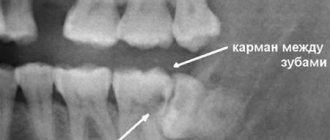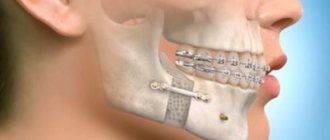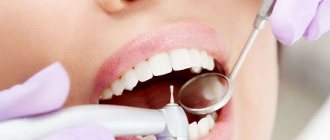Indications and contraindications for molar tooth extraction
It is impossible to determine the indications for the removal of molars in absentia; this requires an examination by an experienced dentist. Recommendations for carrying out extraction are:
- purulent periostitis when it is impossible to drain exudate through the root canal, abscess, phlegmon;
- purulent-inflammatory periodontal diseases, cystic formations, the presence of a tumor;
- longitudinal axial fracture of the dental crown, pulp exposure;
- destruction of the crown, excluding its reconstruction;
- incorrect position of the tooth, as a result of which the mucous membrane is injured or it is impossible to install an orthopedic prosthesis;
- diseases in which destructive changes in bone tissue occur;
- advanced inflammation of the paranasal sinuses, sinusitis.
There are the following contraindications for removal:
- exacerbation of cardiovascular diseases (pre-infarction condition, angina pectoris, arrhythmia, hypertension);
- acute respiratory viral diseases (including influenza and sore throat);
- general diseases of the body (renal failure, pancreatitis, infectious hepatitis);
- damage to the nervous system;
- the presence of neoplasms, hemophilia, leukemia, radiation sickness;
- the first and last months of pregnancy;
- inflammatory dental diseases (gingivitis, stomatitis);
- exhaustion of the patient’s body, dystrophy;
- alcohol intoxication.
Only a doctor has the right to make a decision about removal, carefully weighing all the pros and cons.
Types of anesthetics
Removal of a molar tooth with an injection involves several types of pain relief; the choice is made by the doctor, depending on the location of the molar, the degree of tissue destruction, the expected time of extraction and other factors:
- Applique. This type of anesthesia is used mainly if the patient is afraid of pain from the injection of an injectable anesthetic, as well as when tartar or baby teeth are removed from a child. A special gel or spray is applied to the gum area near the molar.
- Infiltration. This type of anesthesia involves two injections of a substance, from the side of the palate and the lip, the medicine is injected into the apex of the root through the gum. Freezing begins within two minutes after the injections and lasts for another hour after the end of the extraction procedure. Infiltration anesthesia is good because the patient does not feel pain, and there is no numbness in most of the face.
- Conductor. Such anesthesia is necessary when removing wisdom teeth and molars. An injection is made in the area of the trigeminal nerve, as a result of which the sensitivity of a large part of the face is blocked, and numbness persists after extraction for another 1.5–2 hours.
- Intraligamentary. The patient receives an injection into the periodontal fissure, it is carried out under more powerful pressure. The medicinal substance is located inside the bone tissue of the alveolar process, due to which the effect occurs instantly, but lasts about 30 minutes.
- Stem. This type of anesthesia involves serious maxillary surgical interventions; the branches of the maxillary and mandibular nerves are blocked. The injection is injected into the lower edge of the cheekbone, a pronounced freezing effect begins after 10 minutes.
- Sedation. With this type of anesthesia, the patient is depressed or asleep (with deep sedation). The superficial type of such anesthesia allows a person to respond to the doctor’s voice and follow his commands, swallow saliva, open his mouth, while the patient is relaxed and does not feel any discomfort. The medicine is administered through a mask or injected into a vein.
In especially severe cases, when extensive surgery is required, the patient is allergic to other types of anesthesia, or is simply panicky about the extraction procedure, doctors use general anesthesia. However, this method is used extremely rarely, since general anesthesia requires intervention in a hospital setting and under the strict supervision of an anesthesiologist.
At the same time, the medicine remains sterile, it does not need to be opened, and it does not come into contact with air when drawn into a syringe. The thinnest needle ensures minimal discomfort when administering the drug. The following modern anesthetics are used for extraction:
- Articaine is an anesthetic drug that is used in conduction and infiltration anesthesia, when it is necessary to remove several molars in a row;
- Scandonest is a drug contraindicated in adolescents under 15 years of age and elderly patients, as well as people with diabetes, kidney, liver and heart diseases;
- Septanset is a medicine that contains an anesthetic and adrenaline, it is used for the removal of molars, long-term treatment and when cleaning the roots of teeth.
Modern drugs rarely cause allergies, but if a person has a predisposition, he should definitely notify the dentist about this in order to avoid unforeseen situations.
How the removal process occurs (video)
Before removing a diseased tooth, the doctor must take an x-ray to determine the location of the roots. Removal takes place with an anesthetic injection.
The doctor carefully separates the gum, grabs the tooth with forceps and begins to pull it out, rocking or twisting it, depending on the number of roots. After this, you can pull the tooth out of the alveoli. Removing the lower and upper teeth is not much different; the upper molars are somewhat more difficult to grasp correctly.
«
In more advanced cases, the doctor can divide the dental crown into pieces using a drill and tear them apart. This method helps protect the jaw from damage.
When removing an impacted tooth or root fragments, it is first necessary to cut the mucous membrane, free access to the dental crown, and then begin pulling out. This complex removal is often performed under general anesthesia.
Removal of a molar tooth with a cyst requires a highly qualified dental surgeon and is performed under both local and general anesthesia.
Two days after removal, it is necessary to examine the patient and do a control x-ray to exclude the presence of “forgotten” root fragments in the jaw.
Removal steps
Preparation
The dentist-surgeon examines the patient’s oral cavity and prescribes x-rays, if necessary. X-ray examination reveals the structural features, condition and exact location of the roots, and shows the presence of hidden inflammatory processes. The doctor selects the painkiller and dosage, finds out if the patient has any contraindications or allergies.
Important! If you have any fears, doubts or questions, it is best to discuss them with your doctor before the procedure.
Operation
During one operation, the tooth must be fragmented along the roots, and then removed as carefully and minimally invasively as possible, without destroying the bone tissue surrounding the six. In case of complex tooth extraction (if the six is hidden by the gum), the gum is cut, the tooth is destroyed using special tools and removed in parts.
Is it painful to remove a molar tooth, pain after removal
The pain of extraction is a thing of the past - modern painkillers can make the process completely painless, even when removing a tooth with a nerve. The patient is more likely to be concerned about pain after removal.
It is impossible to unequivocally answer the question of how much the gums hurt after such traumatic manipulations. The pain is quite strong at first, but later it will be less intense.
The doctor will definitely recommend an effective pain reliever for the first time.
You should pay attention to the nature of the pain: if it intensifies, becomes “knocking”, tugging, this is a signal about the beginning of dangerous suppuration of the hole. You need to see a doctor as soon as possible.
Preparing to remove the six
- Correct selection of tools. There are several types of forceps and elevators that can only be used when removing specific teeth. An error in choosing a tool leads to quite unpleasant consequences: for example, the removal of the 6th tooth of the upper or lower jaw cannot be carried out with narrow forceps - this will lead to the fact that it will either be crushed, or the patient will feel pain at the time of direct removal.
- Be sure to choose the right anesthesia before the procedure. Most use local anesthesia - an injection of lidocaine or ultracaine. But in some cases, such drugs are not suitable - for example, if the patient has an individual intolerance. Another point that dentists usually do not take into account is the fear of dentists, which amounts to dental phobia. To calm the patient down, you can sedate the patient and the doctor’s removal procedures will be absolutely calm.
- An examination of the oral cavity before tooth extraction is a mandatory procedure. This rule is due to the fact that after the removal of some teeth, problems with neighboring ones may begin. For example, removing a six implies some impact on the entire row.
Features of molar removal during pregnancy
During pregnancy, it is advisable to avoid any surgical interventions that negatively affect the condition of the expectant mother. Ideally, it is best to treat everything prophylactically before the onset of an interesting condition. If your tooth hurts while waiting for your baby, pay attention to the following points:
- Removal is not recommended in the first and last months, when the baby is most vulnerable.
- There is no need to expose the body to unnecessary stress, if we are talking about a planned operation, it is better to wait until the birth of the child.
- Any intervention should be carried out solely for health reasons.
- You definitely need to warn your doctor about your situation, he will select the most harmless anesthetic that does not penetrate the placental barrier.
If tooth extraction is complicated, it is advisable to do it in a hospital under the supervision of experienced doctors; during the first 2-3 days, the temperature may rise, which is extremely undesirable for expectant mothers.
Molar tooth extraction in children
A child’s molar can be either a baby tooth or a permanent tooth; depending on this, treatment tactics are differentiated. If the permanent one has already begun to grow, and the milk tooth has not yet fallen out, but is already wobbly, the pediatric dentist will definitely advise removing the milk tooth that is interfering with normal eruption. If a baby’s permanent molar tooth hurts, the doctor will give preference to conservative treatment in order to preserve the integrity of the dentition.
Premature extraction of baby teeth is undesirable; it negatively affects the formation of the bite.
Clear indications for extraction in children are:
- the presence of a granuloma or dental root cyst.
- inflammation of the tooth root, mandibular nerve.
- complete destruction of the crown.
Features of removing the 6th tooth from below and from above?
Sixes are among those elements of the dentition that are subject to heavy loads during meals. They are involved in the chewing process and for this reason can be destroyed prematurely.
Compared to other units, the extraction process of these teeth is quite difficult. They are distinguished by thickening of the root system, which can be curved or fused.
To carry out a successful operation, it is necessary to involve a doctor with extensive experience, since the location of the units is based in the most dense areas of the alveolar process. Thick partitions between the roots also complicate the procedure. If you compare a six with an eight, it will become clear that its extraction will require more effort, since the 6th molar is more massive and has three roots on the upper jaw.
Possible consequences and complications
Extraction, like any operation, can cause a negative reaction from the body. If your cheek is swollen, your throat hurts, or there is a sharp throbbing pain in the socket, there is a high probability of an inflammatory process.
Early complications:
- fainting, shock, collapse;
- fracture, dislocation of the jaw;
- perforation of the maxillary sinus (when removing an upper molar or premolar), falling of root fragments into the gum;
- trauma, dislocation, fracture of an adjacent or opposite tooth;
- severe bleeding, hematoma formation.
Late complications:
- inflammation of the alveoli (alveolitis);
- inflammation of peripheral nerves (neuritis);
- restriction of jaw movement (muscle contracture).
By contacting a specialist in a timely manner, the consequences of removal can be minimized.
Is it possible to remove it at home?
Removing a tooth on your own is dangerous; at home, it is difficult to ensure sterility, numb the gums, ensure that the root is completely pulled out, and prevent blood loss and other complications. You can remove only a very loose tooth yourself without risk to your health.
Typically, children's loose baby teeth are removed at home. It is important to remove food debris and thoroughly disinfect the oral cavity. You need to tightly grasp the tooth with your fingers wrapped in sterile gauze, loosen it well and only then pull it. If after the second attempt you are unable to pull out the tooth, entrust this difficult manipulation to an experienced dentist without risking your health.
If the tooth comes out of the socket easily, you need to press the gauze swab firmly onto the wound to stop the bleeding and hold it for 30-40 minutes. You should refrain from eating for two hours.
If any unpleasant discomfort occurs, it is advisable to consult a dentist as soon as possible to prevent complications from developing.
Finally, I would like to remind you: simple preventive measures will allow you to keep your smile snow-white and your teeth healthy and strong for many years.
How is the 6th tooth removed in Novosibirsk?
The molar extraction procedure is as follows:
- At the first appointment, the doctor diagnoses the condition, both the affected area and the oral cavity as a whole. At this stage, the feasibility of extraction and the possibility of therapeutic treatment are determined.
- Next, an X-ray examination is performed. It allows you to more accurately assess the problem and select appropriate treatment methods.
- If there are diseases of the oral cavity or inflammation, the affected areas are treated.
- On the day of removal, the patient is given an anesthetic.
- Extraction is carried out using two methods: simple extraction or complex operation. Various methods can be used: full traction, when the unit is removed completely, or partial - with crushing and sawing, when individual parts are removed sequentially.
- The surgical field is treated with special means to stop further infection.
- The wound is closed with stitches.
After 5 days, you need to come for an examination to the dentist to determine the condition of the wound and remove the stitches. If you contact the Aesthetics clinic, you will be treated by qualified and experienced doctors. Our center employs professional surgeons, therapists, implantologists, orthodontists, orthopedists and other dentists who have received permission to work. We use exclusively registered drugs and modern equipment.
What should be the postoperative regimen?
After a simple extraction, the patient needs about 10 minutes of rest; after a complex one, it is better to sit in the waiting room for about half an hour.
- After 15 minutes, you must carefully remove the gauze pad that was placed on the operated area.
- For 4 hours, do not put pressure on the jaw - do not eat.
- Throughout the entire rehabilitation period, take prescribed medications on time.
- If you notice any bleeding, you should consult a doctor.
- Consume food and water only at room temperature. Food should not contain a lot of salt and pepper.
- Rinsing should be done as carefully as possible.
After the anesthesia wears off, the pain may increase, which is normal. But if you have a fever and unbearable pain for a long time, you need to come to the clinic for an examination to rule out infection. At Aesthetics we are always happy to help you.
The articles published on the site are for informational purposes only and the services described may not correspond to the list of services provided in the dental clinic. Please check with the administrator for the availability and cost of procedures.










